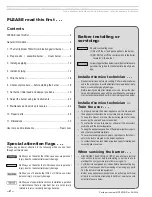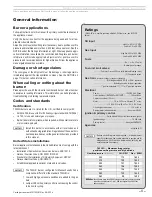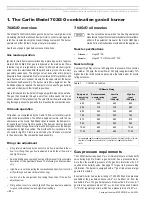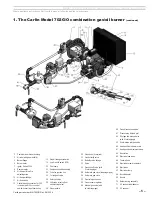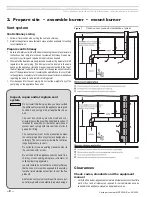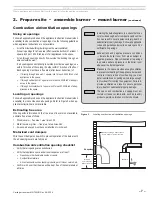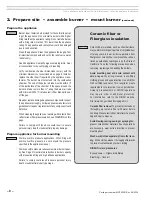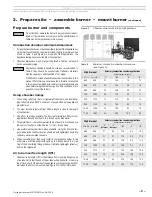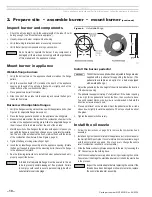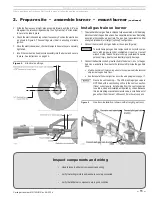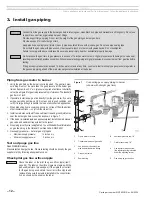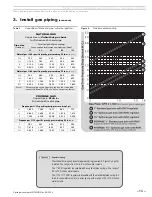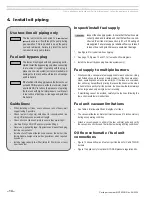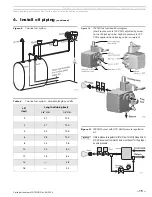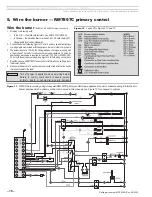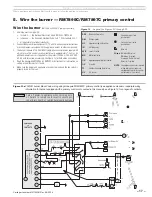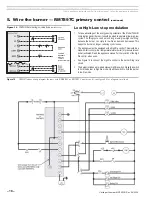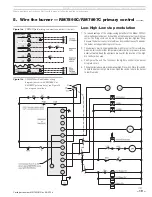
Model 702G/O Advanced gas/oil burners — Instruction manual
Carlin part number MN702GO Rev. 06/23/14
– 4 –
Where appliance instructions differ from this manual, follow the appliance instructions.
702G/O overview
The Model 702G/O combination gas/oil burner is a low-high-low (step
modulating) burner that utilizes a damper motor to control air (and gas fuel
rate). Fuel is selected using the Gas/oil changeover switch. The burner
operates on either #2 fuel oil or gas (natural or propane).
See the next page for gas train component locations.
Gas mode operation
Ignition for main flame is accomplished by a proved gas pilot of approxi-
mately 280,000 Btuh. Pilot gas is introduced at the main burner flame
retention ring, and is ignited by a Carlin 14,000-volt electronic ignitor
wired to the two electrodes. After the pilot flame is proven, the two main
gas safety valves open. The pilot gas valve closes after a time delay to
allow main flame to establish. Flame is monitored both for pilot flame and
main flame with a UV scanner mounted to the under side of the burner
combustion head assembly. The burner main flame begins at low fire.
If additional input is required, the damper motor opens the gas butterfly
valve and air damper to their high fire positions.
Gas is introduced into the burner through a manifold around the air tube.
The gas then circulates through a set of four orifice spuds into the air
stream, ahead of the retention ring. The spin of the air flow at the retention
ring thoroughly mixes the gas/air before it reaches the combustion zone.
Oil mode operation
Oil ignition is accomplished by the Carlin 14,000-volt electronic ignitor
wired to the two electrodes. The oil flame begins at low fire, with 100
psig
oil pressure at the nozzle. If additional input is needed, the damper mo-
tor opens the air to the high fire position. The damper motor end switch
energizes the 2nd stage oil valve (fuel unit blocking valve) as the damper
approaches its high fire position. This provides 300
psig
pressure to the
oil nozzle for high fire. Flame is monitored by the UV scanner mounted
to the under side of the combustion head assembly.
Firing rate adjustment
•
Firing rate is determined by the oil nozzle. Air flow is matched to the oil
flow for oil firing. Then gas flow is adjusted to match the air flow at low
and high fire rates.
•
See the “Starting and operating” section of this manual for the complete
description of the adjustment process. The following is a brief summary
only.
•
High-fire air is set by adjusting the combustion head position (to control
air flow through and around the retention ring).
•
Low-fire air is then adjusted by fine-tuning the position of the low fire
adjusting screw.
•
Pilot gas flow is set for a smooth light-off. Then gas inputs are adjusted
for good combustion at low and high-fire air settings.
1. The Carlin Model 702G/O combination gas/oil burner
702G/O oil nozzles
Use the selections below when the heating equipment
manufacturer’s specific nozzle selection data is not available,
either in the equipment manual or the Carlin OEM Spec
Guide. Follow all instructions provided with the appliance.
Nozzle specifications
•
Preferred
—
Hago 45° SS
•
Alternate
—
Hago 45° P or Monarch 45° PLP
Nozzle ratings
Full input (high fire) occurs at 300 psig nozzle pressure. Since nozzles
are rated at 100 psig, the actual flow at 300 psig is approximately 73%
higher than the rated nozzle capacity. See the table below for nozzle
rating selections.
Table 1
702G/O oil nozzles
Oil Nozzle Sizing
Equipment
Input rating
GPH
Recommended
nozzle rating
GPH
Low fire
input
(100 psig)
High fire
input
(300 psig)
6.00
3.50
3.50
6.00
6.50
3.75
3.75
6.50
6.90
4.00
4.00
6.90
7.80
4.50
4.50
7.80
8.70
5.00
5.00
8.70
9.50
5.50
5.50
9.50
10.40
6.00
6.00
10.40
11.20
6.50
6.50
11.20
1. For a packaged appliance application on which the burner has been tested, use the noz-
zle given in the appliance manufacturer's instructions or supplement for the best
results.
Gas pressure requirements
The 702G/O burner requires 3.4" w.c. minimum pressure at the butterfly
valve during high fire. Select a gas train that has a pressure drop no
more than the available pressure at the gas train inlet minus the 3.4"
needed at the butterfly valve. See page 13 for gas train pressure drop
information. The burner is equipped with a 1" gas train unless a larger
gas train is ordered.
Example: A boiler has an input rating of 1,300,000 Btuh. Gas pressure
available at the gas train entrance is 6.0" w.c. Subtract 3.4” from the
available 6.0" w.c. The gas train pressure drop must be 2.6” or less. A 1"
gas train has a pressure drop of 3.3" w.c., and cannot be used. Select a
1¼" RV-61 regulator gas train, which has a pressure drop of 0.87" w.c.


